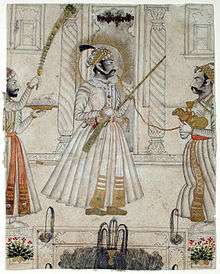Amar Singh II
Amar Singh II[1] (3 October 1672 – 10 December 1710) was the Maharana of Mewar Kingdom (r. 1698–1710). He was a son of Maharana Jai Singh.
| Amar Singh II | |
|---|---|
| Rana of Mewar | |
 Amar Singh II | |
| Rana of Mewar | |
| Reign | 1698–1710 |
| Predecessor | Jai Singh |
| Successor | Sangram Singh II |
| Born | 3 October 1672 |
| Died | 10 December 1710 (aged 38) |
| Father | Jai Singh |
| Sisodia Rajputs of Mewar II (1326–1884) | |
|---|---|
| Hammir Singh | (1326–1364) |
| Kshetra Singh | (1364–1382) |
| Lakha Singh | (1382–1421) |
| Mokal Singh | (1421–1433) |
| Rana Kumbha | (1433–1468) |
| Udai Singh I | (1468–1473) |
| Rana Raimal | (1473–1508) |
| Rana Sanga | (1508–1527) |
| Ratan Singh II | (1528–1531) |
| Vikramaditya Singh | (1531–1536) |
| Vanvir Singh | (1536–1540) |
| Udai Singh II | (1540–1572) |
| Pratap Singh I | (1572–1597) |
| Amar Singh I | (1597–1620) |
| Karan Singh II | (1620–1628) |
| Jagat Singh I | (1628–1652) |
| Raj Singh I | (1652–1680) |
| Jai Singh | (1680–1698) |
| Amar Singh II | (1698–1710) |
| Sangram Singh II | (1710–1734) |
| Jagat Singh II | (1734–1751) |
| Pratap Singh II | (1751–1754) |
| Raj Singh II | (1754–1762) |
| Ari Singh II | (1762–1772) |
| Hamir Singh II | (1772–1778) |
| Bhim Singh | (1778–1828) |
| Jawan Singh | (1828–1838) |
| Sardar Singh | (1828–1842) |
| Swarup Singh | (1842–1861) |
| Shambhu Singh | (1861–1874) |
| Sajjan Singh | (1874–1884) |
| Fateh Singh | (1884–1930) |
| Bhupal Singh | (1930—1955) |
Reign
Maharana Amar Singh II succeeded his father Maharana Jai Singh, at a juncture when the whole of Rajputana was scattered with divided kingdoms and nobles. Maharana Amar Singh II made various reforms for the prosperity of his people and Mewar but his major contribution was his alliance with rebel kingdoms of Amber and Marwar. During his reign, the Mughal power was on a decline with multiple revolts and uprisings. Amar Singh II took advantage of this time and entered into a private treaty with the Mughals. At the same time he entered into matrimonial alliance with Amber, sealing his friendship by giving his daughter to Sawai Jai Singh of Jaipur in matrimony. The kingdoms of Udaipur, Amber and Marwar, united now formed a triple league against the Mughal.
Special rules were set for Rajput states, so as to strengthen the Rajputana and denying assistance to the Mughal. Amar Singh II nevertheless fought with stronger efforts for the freedom of Mewar and other Rajput states. He also fought against the Jaziya; a religious tax imposed on the Hindus for their pilgrimage.
But with the death of Amar Singh II, the legacy and efforts of an independent brave king also died, who tried to unite the Rajputana against the Mughal for the freedom of his people and prosperity of his motherland.[2][3]
References
- "UDAIPUR". Archived from the original on 27 December 2016. Retrieved 15 July 2013.
- The Cambridge History of India, Volume 3 pg 322
- http://www.eternalmewarblog.com/rulers-of-mewar/maharana-amar-singh-ii/
- Kossak, Steven (1997), Indian court painting, 16th–19th century, New York City: The Metropolitan Museum of Art, ISBN 0870997831 (see p. 88-89; plate 51)